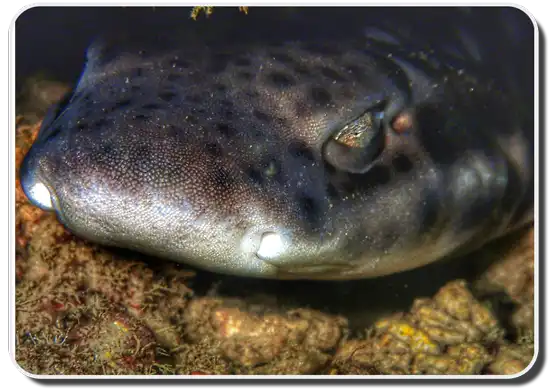Whitespotted bamboo sharks are a species of small, nocturnal, bottom-dwelling sharks belonging to the family Hemiscylliidae.
These carpet sharks are native to the Indo-West Pacific and are sought after as pets in aquariums due to their vibrant body color.

White Bamboo Shark Scientific Classification |
|
| Kingdom | Animalia |
| Phylum | Chordata |
| Class | Chondrichthyes |
| Order | Orectolobiformes |
| Family | Hemiscylliidae |
| Genus | Chiloscyllium |
| Scientific Name | Chiloscyllium plagiosum |
Description
Adult whitespotted bamboo sharks have been known to grow up to 23.6-31.5 inches. The largest known male and female specimens measured 32.7 and 37.4 inches, respectively.
Their slender body is generally brownish with multiple transverse dark bands and irregular white/blue or purple and pink spots. Albinism is quite rare in sharks, and some instances of albino whitespotted bamboo sharks have been recorded in captivity. Downtown Aquarium in Colorado’s Denver city has had albino specimens of this species annually since 2007, with some exhibited to the public. In another instance, three albino whitespotted bamboo sharks hatched in captivity in Sea World Orlando in Orlando, Florida.
Their head consists of a rounded, sturdy snout. Small spiracles lie beneath their eyes, while nasal barbells present near each nostril resemble cats’ whiskers, resulting in their alternate name cat sharks.
They have strong jaws containing rows (26-35 in upper and 21-32 in lower) of sharp teeth, each consisting of one central cusp.
The first and the second dorsal fins are similar in size to each other and to the pelvic fin.Their first dorsal fin lies behind the insertion of their pelvic fin. In contrast, the anal fin remains positioned to the front of the caudal fin.
Where do they live
Map Of The Whitespotted Bamboo Shark’s Habitat

The populations of the whitespotted bamboo shark are spread across the waters of India, Sri Lanka, Indonesia, Madagascar, Thailand, Singapore, China, Korea, Vietnam, Taiwan, Japan, and the Philippines.
These sharks inhabit inshore spots like coastal areas and coral reefs in the Pacific waters.
Behavior
Dietary
These sharks are nocturnal, hunting and feeding at night. They are bottom-feeders and prey on small marine fishes, crabs, and shrimps.
Reproductory
Whitespotted bamboo sharks are oviparous, with the young ones hatched from the eggs laid by their mother. The eggs measure around 5 inches in length. The mating season varies from one species to the other depending on geographical location.
The species inhabiting the Taiwanese coast mate during December and January, after which ovulation occurs between March and May. Eggs hatch following a pregnancy period lasting 14-15 weeks, with the newborn pups measuring 6 inches in length.
There have been reports of female sharks in Detroit who had given birth without fertilization after being kept in an aquarium for six years without mates. This is a possible case of parthenogenesis, as suggested by some researchers speculated, where the female has somehow self-fertilized the eggs without any sperm. Another explanation of this phenomenon might be the ability of females to store sperm for a long time resulting in such a delayed birth.
The young sharks reach sexual maturity at a body length of 65cms.
 Adaptations
Adaptations
Bamboo Sharks have muscular pectoral fins that are bent and slightly depressed. They prop up the sandy ocean floor with the help of these pectoral fins and rest. These fins also help the shark to crawl on the bottom surface and search for prey.
The sensory receptors in their snouts help these sharks to effectively find prey buried in the sands of the ocean surface.
These sharks have small, strong teeth to grind or crush prey like crabs with a tough exoskeleton.
Interactions with humans
There have been no records of these sharks harming humans. Moreover, due to their bottom-dwelling nature, these sharks are a much sought-after home-aquarium species.
In other cultures, these sharks have multiple commercial values. They are consumed as food in Taiwan, Madagascar, and especially in China, where these sharks are also used in traditional medicine.
Although caught extensively by hook-and-line and trawls in countries like India, Thailand, and China, their population remain stable due to their capability of breeding and adapting readily in captivity.
The whitespotted bamboo shark has suffered a decline in its population due to constant threats from human consumption and habitat destruction. Dynamite fishing, cyanide fishing, and accumulation of plastic wastes in the ocean are why the IUCN has listed the species as “Near Threatened”.
